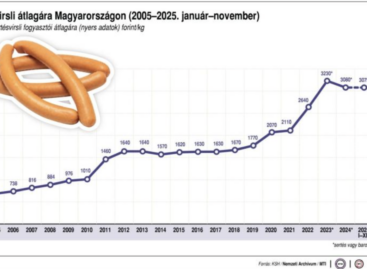Was the “chips tax” a success – how to fight obesity in Hungary?
More and more Hungarians are struggling with being overweight and the situation is getting worse. If we take a look at the figures, we can see that obesity is a growing problem.
This article is available for reading in Trade magazin 2024/10

Guest writer:
Zombor Berezvai
associate professor
Corvinus University

Guest writer:
József Vitrai
chair
Association for the
Renewal of Hungarian
Public Health
In 2019 one in three Hungarians was classified as overweight and 24% as obese. The obesity rate in Hungary is above the 16% EU average and has even increased from the 21% back in 2014. For men the situation is particularly worrying and young people are no exception. A quarter of 15-year-old Hungarians have this problem, which is a very high proportion at a European level.
The public health product tax as a possible solution and its problems
One of the main objectives of the introduction of the public health product tax (NETA) in 2011 was to reduce the consumption of foods that very much contribute to obesity, thereby improving the public health situation in Hungary. Initially the tax was imposed on soft drinks, chocolates and biscuits with added sugar, as well as high-salt crisps and other snacks. Since then the range of products covered by the tax has expanded considerably. There are three main problems with NETA as a tool to address public health problems. Firstly, the targeting of the tax wasn’t accurate and got even worse over time. For instance it didn’t refer to milk-based drinks with added sugar. Secondly, NETA is only a treatment for the symptoms, as it doesn’t change the food environment or consumer preferences. Rising prices can only temporarily reduce consumption, which then starts to grow again as incomes hike. According to GfK ConsumerScan data, in 2015 we consumed almost as much of the products covered by NETA as before the introduction of the tax, and by 2018 we could see a significant rise from baseline for most products. Thirdly, NETA is regressive, hitting poorer families and households harder, as they are more vulnerable and typically in poorer health.
Systemic solutions
Many measures to tackle obesity and other health problems are currently implemented at the phenomenon level, e.g. educating consumers about high-sugar drinks. These are reactive measures that are often viewed as quick solutions, but actually do little to change the complex system that causes obesity. At the level of the structure of the complex system that generates obesity, interventions can have a greater impact by reducing the likelihood of future events (that is the patterns of the phenomenon) recurring. Actions that focus on the goals and beliefs of those involved in the design and operation of a complex system and of decision-makers can induce fundamental changes in the structure and functioning of the system, thereby inhibiting its obesity-generating function.
Recommendations for policy makers and businesses
In the light of the above, the integration of psychological, economic and public health knowledge and understanding is needed when defining effective prevention measures and strategies. Some examples are: 1. Introduction of educational materials to increase health literacy. 2. Coordination of different public policies (e.g. public health, sports policy, tax policy, agricultural marketing) to reduce obesity. 3. Transforming the food environment to promote healthy eating, e.g. by improving access to and affordability of controlled, toxin-free fruit and vegetables. 4. Much stricter regulation of advertising products linked to health risk. 5. Restructuring sports subsidies to promote mass sport and active leisure. //
Related news
Tesco rolls out fresh produce campaign
🎧 Hallgasd a cikket: Lejátszás Szünet Folytatás Leállítás Nyelv: Auto…
Read more >Hungarian confectionery industry: balancing between challenges and opportunities
🎧 Hallgasd a cikket: Lejátszás Szünet Folytatás Leállítás Nyelv: Auto…
Read more >March 4th is World Obesity Day
🎧 Hallgasd a cikket: Lejátszás Szünet Folytatás Leállítás Nyelv: Auto…
Read more >Related news
The GVH imposed fines of more than 3.7 billion forints on 29 companies in 2025
🎧 Hallgasd a cikket: Lejátszás Szünet Folytatás Leállítás Nyelv: Auto…
Read more >Hungary’s economy in 2025: recovery from slowdown, weaker forint and the increasing importance of corporate strategic decisions 2026 will be a test of resilience
🎧 Hallgasd a cikket: Lejátszás Szünet Folytatás Leállítás Nyelv: Auto…
Read more >NAK: it’s worth buying Hungarian sausages on New Year’s Eve too
🎧 Hallgasd a cikket: Lejátszás Szünet Folytatás Leállítás Nyelv: Auto…
Read more >






